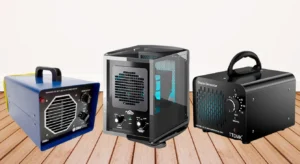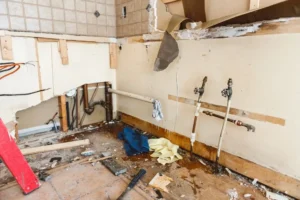Your HVAC (Heating, Ventilation, and Air Conditioning) system is essential for maintaining comfort in your home, but it can also be a source of potential water damage if not properly maintained. At RestoTek in Georgetown, Texas, we understand the importance of preventing and addressing HVAC-related water damage issues promptly. Let’s explore how HVAC systems can cause water damage and what you can do to safeguard your home.
Common Causes of HVAC Water Damage
- Condensate Drain Line Clogs: Over time, algae, mold, and debris can accumulate in the condensate drain line, leading to blockages. When this happens, water backs up into the system and can overflow, causing water damage near the HVAC unit.
- Clogged Air Filters: Dirty or clogged air filters restrict airflow, causing the evaporator coil to freeze. When the ice melts, it can overwhelm the drip pan and cause water to overflow, damaging ceilings, walls, and flooring.
- Leaky or Damaged Pipes: HVAC systems have components like pipes and fittings that can develop leaks due to age, corrosion, or improper installation. These leaks can result in water pooling around the unit or within walls and floors.
- Improper Installation: Poor installation of HVAC systems can lead to incorrect sizing, inadequate drainage, or improper sealing, increasing the risk of water damage over time.
Signs of HVAC-Related Water Damage
- Water Stains or Discoloration: Look for water stains on ceilings, walls, or near the HVAC unit.
- Musty Odors: Mold and mildew thrive in damp environments, so a musty odor near the HVAC system may indicate hidden water damage.
- Visible Mold Growth: Check for mold growth around the HVAC unit or nearby areas, as mold can develop rapidly in moist conditions.
- Increased Humidity Levels: Excessive humidity indoors can be a sign of HVAC issues leading to water accumulation.
Preventive Maintenance Tips
- Regular Inspections: Schedule routine inspections and maintenance checks for your HVAC system by qualified technicians to identify and address potential issues before they escalate.
- Change Air Filters: Regularly replace air filters to maintain proper airflow and prevent the evaporator coil from freezing.
- Clean Condensate Drain Line: Keep the condensate drain line clear of debris by flushing it with a mixture of bleach and water annually.
- Monitor Moisture Levels: Use a humidity monitor to keep track of indoor humidity levels, ensuring they remain within the recommended range to prevent mold growth.
What to Do If You Suspect HVAC Water Damage
If you notice signs of HVAC-related water damage in your home, it’s essential to act quickly:
- Turn Off the HVAC System: Shut off the HVAC system to prevent further water damage and potential electrical hazards.
- Contact a Professional: Seek help from a certified water damage restoration company like RestoTek Restoration. Our experienced team will assess the damage, mitigate further issues, and restore your home to its pre-damage condition.
- Document the Damage: Take photos and videos of the affected areas for insurance purposes before cleanup and restoration efforts begin.
Trust RestoTek for HVAC Water Damage Restoration
At RestoTek, we specialize in comprehensive water damage restoration services, including those caused by HVAC system failures. Our team is dedicated to providing prompt, professional, and reliable solutions to protect your home and restore peace of mind.
Visit our website to learn more about our water damage restoration services and how we can help safeguard your home from HVAC-related water damage. Trust RestoTek for expert solutions and superior customer service.



